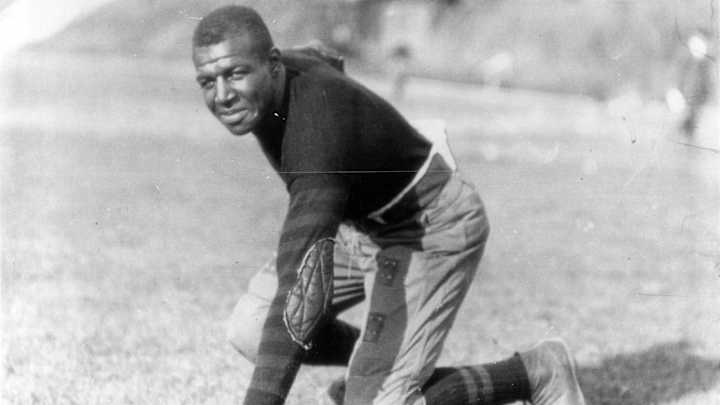Iowa Football Look Forward to Competing on Duke Slater Field

IOWA CITY, Iowa - LeVar Woods lived in Slater Hall as a University of Iowa freshman in 1996. “Room 719,” he said.
Woods had no idea who the man was that his dormitory was named after. No idea that Fred “Duke” Slater was Iowa’s first black all-American in 1919, at a time when African-American students weren’t allowed to live in university dormitories. No idea that Slater was the first man of color to play in the National Football League.
But a year later, when Woods lived in Room 338 at Slater, he had done his research. “I actually took the time and learned about Duke Slater,” Woods said. “I’ve been fascinated ever since.”
Like Slater, Woods came to Iowa to play football. And like Slater, he made it to the NFL. Now LeVar is in his 14th season as a member of the Hawkeye coaching staff under Kirk Ferentz. And Saturday, when Iowa opens the 2021 season against Indiana in a Top 25 duel at Kinnick Stadium, Woods will leave the locker room, walk down the tunnel and step onto Duke Slater Field.
“I think it’s going to be a good thing, not only for this university but for the Big Ten and the country,” Woods said. “Duke Slater was an incredible person. It would have been great to play with the guy.”
Back in 1972, when Iowa Stadium became Kinnick Stadium in honor of 1939 Heisman Trophy winner Nile Kinnick, Slater’s name was also considered. University President Willard “Sandy” Boyd floated a Kinnick-Slater Field proposal. But the Board of Regents went with Kinnick, who lost his life as a Navy pilot in World War II. Slater’s consolation prize was a dorm named for him. When Iowa renovated the north end zone of the stadium, a project that was completed in 2019, a bronze relief of Slater making a key block in Iowa’s 1921 upset of Notre Dame was one of the improvements.
The Board of Regents voted in late July to name the field in Slater’s honor. “I’m very excited to play on that field, and represent him,” standout junior running back Tyler Goodson said. “He’s an icon, and I think everyone wants to be like him...all the accolades, everything he’s done for the school. He has been a great role model.”
Slater, who carried 210 pounds on his 6-foot 2-inch frame, played tackle on both sides of the ball. He carved out space for teammates like Aubrey Devine and Gordon Locke on offense and was unblockable on defense.
In addition to twice earning all-America honors, Slater was a three-time all-Big Ten selection. As a senior in 1921, he was a major reason the team finished undefeated. He also lettered in track.
Slater was the first African-American player to be enshrined in the National Football Foundation College Hall of Fame. He was a member of the inaugural class in 1951.
Slater was also elected to the Pro Football Hall of Fame, part of the Centennial Class of 2020. He played 10 seasons professionally. He also returned to Iowa to earn his law degree and went on to become a popular and respected judge in Chicago. He died in 1967 at 66 years of age. Like Woods, Kelvin Bell came to Iowa to play football and is now a member of the coaching staff. A native of Mississippi, Bell is a nine-year veteran of the Hawkeye staff and is in his third season as the defensive line coach.
Bell has a card of Duke Slater in the window of his office.
“He’s a pioneer,” Bell said. “You talk about a man of color, who was able to do the things he did here at the university, he's a real trailblazer for us.”
Bell said the fact that Slater is being honored with a field in his name is a sign of progress. “For us to have his name on that field, and for 69,000 or 70,000 people to be able to see it and recognize it, and have it recognized on a national television stage, that’s the type of platform you want.”
It is a way to say thank you for one of the greatest Iowa football players of all time.
“Not just him, but countless men of color who have done great things at this university and are still waiting for their time, and for their name to be said, too,” Bell said. “But it’s a great start, and I’m proud of it. And it’s not something I’m going to take for granted when I walk out there.” Junior wide receiver Tyrone Tracy would like to follow Slater’s steps to the NFL. “Playing on a field named after him speaks volumes,” Tracy said.
Tracy’s future will depend, in some measure, to what he accomplishes on Slater Field the remainder of his college career.
“Leaving a name for yourself, that’s all you can ask for,” Tracy said. “I’ve always tried to leave the jersey in a better place. I’m a hard-working man. Every time I go on the field, I’m dedicated to what I do.”
Senior running back Ivory Kelly-Martin is glad that the university has honored Slater in this way, and he’s determined to learn more about his story.
“This means a lot to me, and it means a lot to all Hawkeyes,” Kelly-Martin said. “Not just people of my race, but everybody. It’s nice that people like this are being celebrated, being supported and given a stage. It gives you a better understanding of the things he had to go through back then.”
